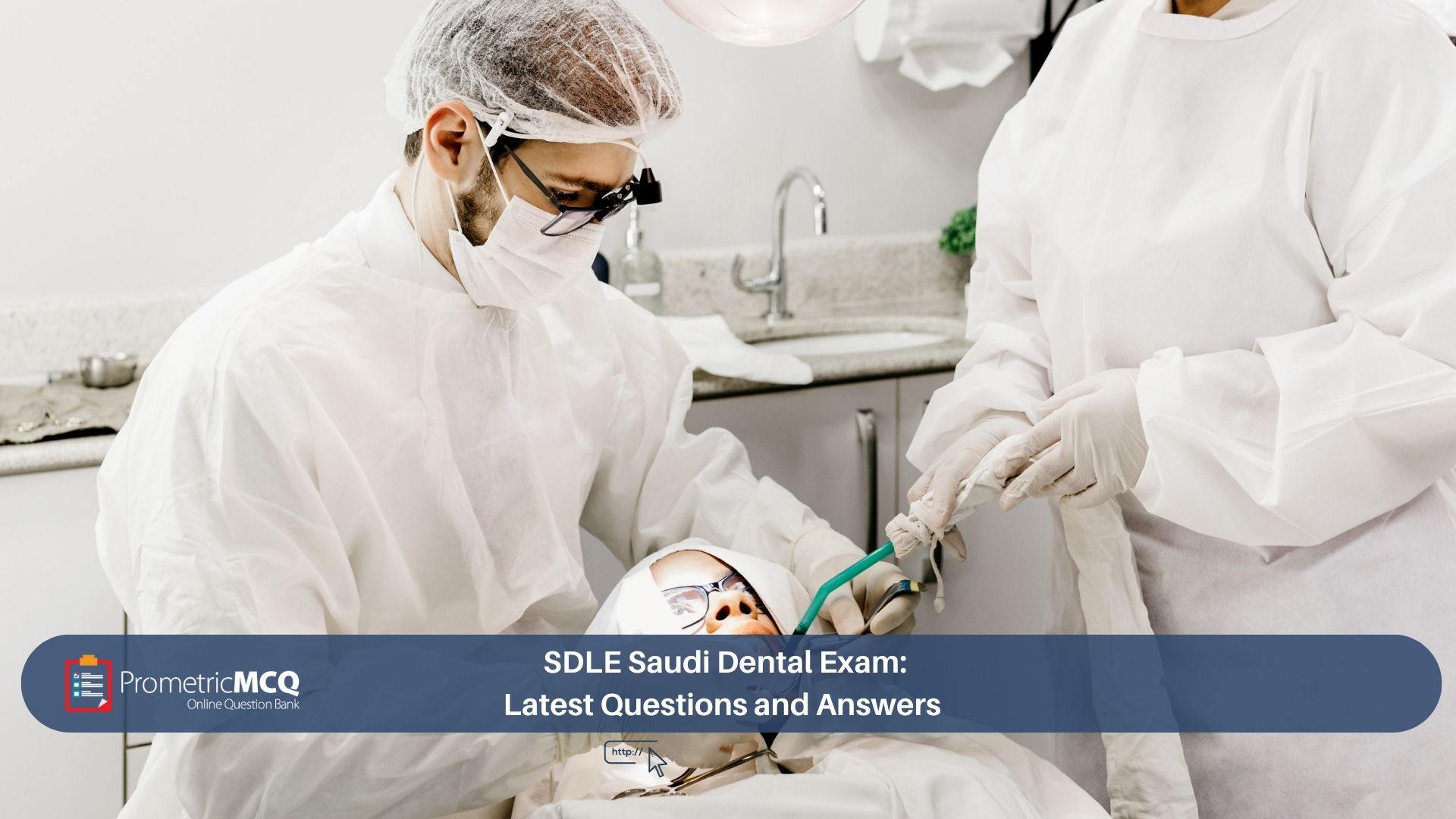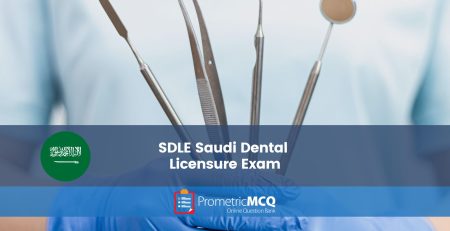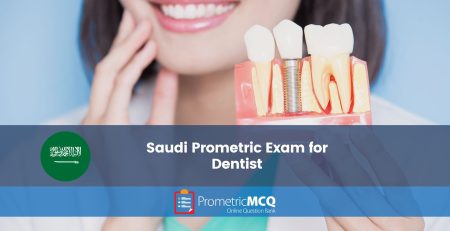
SDLE Saudi Dental Exam: Latest Questions and Answers
fatima@prometricmcq.com2025-09-27T00:43:17+00:00Table of Contents
ToggleSDLE Saudi Dental Exam: Latest Questions and Answers (2025)
The Kingdom of Saudi Arabia’s healthcare sector is undergoing a transformative journey, establishing itself as a hub of medical and dental excellence. For dentists aspiring to contribute to and thrive in this advanced environment, the Saudi Dental Licensing Exam (SDLE) is the essential rite of passage. Administered by the Saudi Commission for Health Specialties (SCFHS), the SDLE is a rigorous, high-stakes examination that ensures every practitioner possesses the clinical competence, diagnostic skills, and ethical grounding required to deliver outstanding patient care.
The SDLE is a sophisticated test of clinical application, not rote memorization. It is composed entirely of case-based Multiple-Choice Questions (MCQs) designed to simulate the complexities of modern dental practice. You will be challenged to analyze patient scenarios, interpret various radiographs, formulate sound treatment plans, and make critical decisions. The most effective preparation method is to immerse yourself in the exam’s style by practicing with high-quality, up-to-date questions and meticulously studying their answers and rationales.
This ultimate 2025 guide is your definitive resource for the SDLE, built around a core of the latest sample questions and detailed answers. We will deconstruct the exam’s pattern, provide a strategic breakdown of the high-yield syllabus topics, and conclude with a comprehensive 10-point FAQ section to clarify every step of your journey. This guide is your playbook for mastering the SDLE and securing your professional future in Saudi Arabia.
Key Takeaways for the SDLE
- Clinical Diagnosis is Paramount: A significant portion of the exam tests your ability to accurately diagnose conditions from clinical and radiographic evidence.
- Treatment Planning is a Core Competency: You must be able to formulate logical, sequential, and evidence-based treatment plans.
- Radiographic Interpretation is Essential: Mastery of interpreting periapical, bitewing, and panoramic (OPG) radiographs is non-negotiable.
- Know Your Dental Materials: A deep understanding of the properties and clinical applications of common dental materials is frequently tested.
- Active Learning Through MCQs: The most efficient and effective study strategy is to solve thousands of case-based questions from a specialized QBank.
Deconstructing the SDLE: Exam Pattern and Syllabus
A successful study strategy is founded on a clear understanding of the exam’s architecture. The SDLE follows a standardized Prometric format, and knowing its structure is a key part of your overall SCFHS exam passing strategy.
Core Exam Framework
- Administrator: Prometric, on behalf of the SCFHS.
- Format: Computer-Based Test (CBT) with 100% MCQs.
- Structure: 200 MCQs, typically divided into two sections of 100 questions each.
- Duration: A total of 4.5 hours of testing time (2 hours and 15 minutes per section), with a scheduled break in between.
- Scoring: The exam is scored out of 800, with an official passing score of 500. There is no negative marking.
High-Yield SDLE Syllabus Breakdown
The SDLE is a comprehensive exam for general dentists. A strategic plan allocates the most time to the most heavily weighted domains.
| Dental Domain | Approximate Weighting & High-Yield Topics |
|---|---|
| Restorative Dentistry & Endodontics | ~30-35%: This is the largest block. Includes caries diagnosis, principles of cavity preparation, dental materials, adhesive dentistry, and the full spectrum of endodontics from pulpal diagnosis to obturation and management of complications. |
| Prosthodontics (Fixed & Removable) | ~15-20%: Principles of tooth preparation for crowns and bridges, impression materials, complete and removable partial denture design, occlusion, and fundamentals of implant prosthodontics. |
| Oral Surgery, Oral Medicine & Radiology | ~15-20%: Extractions, local anesthesia, management of common oral pathologies (cysts, tumors), diagnosis of oral mucosal diseases, and extensive radiographic interpretation. |
| Periodontics | ~10-15%: Diagnosis and classification of periodontal diseases, non-surgical and surgical periodontal therapy, and understanding the relationship between periodontal health and systemic diseases. |
| Pediatric Dentistry & Orthodontics | ~10-15%: Management of the primary and mixed dentition, pulp therapy for primary teeth, space maintenance, and diagnosis of common malocclusions (Angle’s classification). |
| Preventive Dentistry & Community Health | ~5%: Principles of fluoride application, sealants, and basic epidemiology. |
Latest SDLE Questions and Answers: A Free Practice Set
This collection of MCQs is designed to reflect the style and difficulty of the 2025 SDLE. Engage with each case, formulate your answer, and then carefully study the rationale to master the clinical reasoning process. For a truly comprehensive preparation, a full bank of SDLE Saudi Dental Licensure Exam Questions is your most critical asset.
Question 1: Oral Pathology & Radiology
A panoramic radiograph of an asymptomatic 18-year-old male reveals a large, well-defined, multilocular radiolucency in the posterior mandible, causing displacement of the third molar. The lesion has a “soap bubble” appearance. What is the most likely diagnosis?
- Dentigerous Cyst
- Odontogenic Keratocyst (OKC)
- Ameloblastoma
- Radicular Cyst
Correct Answer: C (Ameloblastoma)
Rationale: The key features described are classic for an ameloblastoma. It is a benign but locally aggressive odontogenic tumor. The classic radiographic presentation is a multilocular (“soap bubble” or “honeycomb”) radiolucency, most commonly found in the posterior mandible of young adults. It often causes significant expansion of the jaw and displacement of teeth, as described in the scenario. While other lesions can be multilocular, this combination of features is most indicative of an ameloblastoma.
Why other options are incorrect:
A: A dentigerous cyst is a unilocular radiolucency that is always associated with the crown of an unerupted tooth.
B: An OKC can be multilocular and is known for its high recurrence rate, but it typically grows along the bone without causing significant expansion, unlike an ameloblastoma.
D: A radicular cyst is the most common odontogenic cyst, but it is always associated with the apex of a non-vital tooth and presents as a unilocular radiolucency.
Question 2: Prosthodontics
When designing a mandibular removable partial denture for a Kennedy Class I arch (bilateral free-end edentulous areas), what is the primary function of the indirect retainer?
- To provide bracing against lateral forces.
- To prevent the denture from moving towards the tissue.
- To prevent the distal extension base from lifting away from the tissue.
- To retain the denture against dislodging forces during mastication.
Correct Answer: C
Rationale: This question tests a fundamental principle of RPD design for distal extension cases. The indirect retainer is a component that rests on a tooth surface (usually a cingulum or mesial occlusal rest) anterior to the fulcrum line. The fulcrum line is an imaginary line connecting the most posterior rests. When sticky foods lift the distal extension base, the denture rotates around this fulcrum line. The indirect retainer engages on the opposite side of the fulcrum, preventing this rotational lifting movement and keeping the denture base seated against the tissue.
Why other options are incorrect:
A: Bracing is provided by components like guide plates and major connectors.
B: Preventing movement towards the tissue is the function of the occlusal rests.
D: Retention against vertical dislodgement is the primary function of the direct retainers (clasps).
Question 3: Periodontics
A patient with generalized chronic periodontitis is undergoing non-surgical periodontal therapy. Which of the following microorganisms is most strongly associated with this condition and is a primary target of the therapy?
- Streptococcus mutans
- Actinomyces viscosus
- Lactobacillus acidophilus
- Porphyromonas gingivalis
Correct Answer: D (Porphyromonas gingivalis)
Rationale: Chronic periodontitis is associated with a specific group of gram-negative anaerobic bacteria. Porphyromonas gingivalis, along with Tannerella forsythia and Treponema denticola, form the “red complex,” which are strongly implicated as the primary pathogens in the progression of periodontal disease. P. gingivalis is a keystone pathogen that orchestrates the dysbiotic inflammatory response leading to pocket formation and bone loss. Therefore, scaling and root planing aims to disrupt the biofilm and reduce the bacterial load of these specific pathogens.
Why other options are incorrect:
A & C: Streptococcus mutans and Lactobacillus acidophilus are gram-positive bacteria that are primary etiologic agents of dental caries, not periodontitis.
B: Actinomyces species are early colonizers in plaque formation but are not considered primary pathogens in chronic periodontitis.
Frequently Asked Questions (FAQs) for the SDLE
The SCFHS uses a scaled scoring system. The SDLE is scored on a scale out of 800, and the official passing score is 500. This is a standardized score, not a percentage, ensuring a consistent level of difficulty across different exam forms.
Candidates are typically allowed four attempts to pass the SDLE. There are specific regulations regarding the time between attempts, so it is essential to consult the official SCFHS website for the most current policies.
Both are comprehensive, case-based exams for general dentists. The core clinical content is very similar, as both are based on international evidence-based standards. The main differences lie in the exact format (number of questions, timing) and the administrative body. A dentist who is well-prepared for the INBDE would have a strong foundation for the SDLE. For more on international standards, you can refer to bodies like the American Dental Association (ADA).
No, the SDLE is a clinical competency exam based on international dental science and best practices. It does not test knowledge of local laws, public health statistics, or administrative policies.
The Primary Source Verification (PSV) by DataFlow is a mandatory credentialing step. You can typically start the process before or after the exam, but you must have a positive DataFlow report before the SCFHS will issue your final Saudi SCFHS license for practice.
The consensus among successful candidates is that the most critical study tool is a high-quality, comprehensive question bank (QBank) that focuses on case-based scenarios and provides detailed rationales. This active learning approach is superior to passive reading for mastering clinical reasoning.
A focused, dedicated study period of 4 to 6 months is generally recommended for most dentists to thoroughly cover the extensive syllabus and complete a large QBank with proper review.
No, the exam uses only generic names for all drugs and generic classifications for all materials (e.g., “glass ionomer cement,” “polyvinyl siloxane”).
Time management is crucial. Use the scheduled break between the two sections to rest and refocus. During each section, aim to pace yourself at just over one minute per question. Use the “flag” feature for questions you are unsure about and return to them at the end of the section if you have time. Do not get stuck on a single difficult question.
Supplement your QBank practice with a good oral radiology textbook or atlas (e.g., White and Pharoah’s Oral Radiology). Practice a systematic approach: look at the teeth, then the periodontal structures, then the surrounding bone. This ensures you don’t miss important findings.
Conclusion: Your Gateway to a Dental Career in Saudi Arabia
The Saudi Dental Licensing Exam is a rigorous and comprehensive assessment designed to uphold the highest standards of dental care in the Kingdom. It is a challenging but achievable milestone for the dedicated and strategically prepared candidate. By understanding the exam’s pattern, focusing on high-yield clinical topics, and committing to an intensive practice regimen with the latest, high-quality MCQs, you can build the skills and confidence to excel. Passing the SDLE is your definitive step toward a professionally and personally rewarding dental career in Saudi Arabia.
Ready to Master the SDLE and Secure Your License?
Our premier SDLE question bank is filled with thousands of high-yield clinical scenarios, detailed, evidence-based rationales, and full-length simulated exams designed to cover the entire SCFHS syllabus and guarantee your success.



